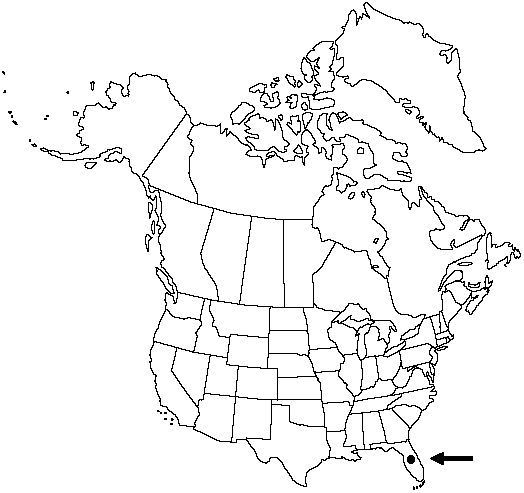Difference between revisions of "Dennstaedtia bipinnata"
Proc. Biol. Soc. Wash. 61: 39. 1938.
FNA>Volume Importer |
FNA>Volume Importer |
||
| Line 20: | Line 20: | ||
}}<!-- | }}<!-- | ||
| − | --><span class="statement" id="st- | + | --><span class="statement" id="st-undefined" data-properties=""><b>Stems </b>long-creeping, 5–6 mm diam. <b>Leaves</b> clustered to well separated, arching, 1.5–2.5 × ca. 1 m. <b>Petiole</b> straw-colored to brown, darker at base, lustrous, 1/2 to equal length of blade, sparsely pubescent with soft, jointed hairs at base when young. <b>Blade</b> bright green, lustrous, ovate, 2–4-pinnate, 1/2 to nearly as wide as long, base obtuse, apex acute, sparsely pubescent throughout to nearly glabrous abaxially. <b>Basal</b> segments of pinnules opposite; ultimate segments mostly oblong-ovate, base inequilaterally cuneate, margins incised-dentate. <b>Sori</b> globose to almost cylindric; indusia tubular or cylindric. <b>Spores</b> trilete, prominently 3-lobed, surface irregularly tuberculate. <b>2n</b> = 188.</span><!-- |
-->{{Treatment/Body | -->{{Treatment/Body | ||
| + | |phenology=Sporulates spring and early summer. | ||
|habitat=Moist to wet, forested habitats in acid soils | |habitat=Moist to wet, forested habitats in acid soils | ||
|elevation=0 m | |elevation=0 m | ||
| Line 42: | Line 43: | ||
|basionyms=Dicksonia bipinnata | |basionyms=Dicksonia bipinnata | ||
|family=Dennstaedtiaceae | |family=Dennstaedtiaceae | ||
| + | |phenology=Sporulates spring and early summer. | ||
|habitat=Moist to wet, forested habitats in acid soils | |habitat=Moist to wet, forested habitats in acid soils | ||
|elevation=0 m | |elevation=0 m | ||
| Line 49: | Line 51: | ||
|publication year=1938 | |publication year=1938 | ||
|special status= | |special status= | ||
| − | |source xml=https://jpend@bitbucket.org/aafc-mbb/fna- | + | |source xml=https://jpend@bitbucket.org/aafc-mbb/fna-data-curation.git/src/9216fc802291cd3df363fd52122300479582ede7/coarse_grained_fna_xml/V2/V2_56.xml |
|genus=Dennstaedtia | |genus=Dennstaedtia | ||
|species=Dennstaedtia bipinnata | |species=Dennstaedtia bipinnata | ||
| − | |||
| − | |||
| − | |||
| − | |||
| − | |||
| − | |||
| − | |||
| − | |||
| − | |||
| − | |||
| − | |||
| − | |||
| − | |||
| − | |||
| − | |||
| − | |||
| − | |||
| − | |||
| − | |||
| − | |||
| − | |||
| − | |||
| − | |||
| − | |||
| − | |||
| − | |||
| − | |||
| − | |||
| − | |||
| − | |||
| − | |||
}}<!-- | }}<!-- | ||
-->[[Category:Treatment]][[Category:Dennstaedtia]] | -->[[Category:Treatment]][[Category:Dennstaedtia]] | ||
Revision as of 13:23, 27 July 2019
Stems long-creeping, 5–6 mm diam. Leaves clustered to well separated, arching, 1.5–2.5 × ca. 1 m. Petiole straw-colored to brown, darker at base, lustrous, 1/2 to equal length of blade, sparsely pubescent with soft, jointed hairs at base when young. Blade bright green, lustrous, ovate, 2–4-pinnate, 1/2 to nearly as wide as long, base obtuse, apex acute, sparsely pubescent throughout to nearly glabrous abaxially. Basal segments of pinnules opposite; ultimate segments mostly oblong-ovate, base inequilaterally cuneate, margins incised-dentate. Sori globose to almost cylindric; indusia tubular or cylindric. Spores trilete, prominently 3-lobed, surface irregularly tuberculate. 2n = 188.
Phenology: Sporulates spring and early summer.
Habitat: Moist to wet, forested habitats in acid soils
Elevation: 0 m
Distribution

Fla., Mexico, West Indies, Central America, South America to Bolivia.
Discussion
Dennstaedtia bipinnata was first found in Florida in 1926 around Lake Okeechobee (J. K. Small 1938). These populations have been extirpated and have been replaced by sugar cane and other agriculture. Populations in Seminole County may be naturalized. The species has been reported as occurring in Okeechobee County. Collections made in the 1920s from Palm Beach County suggest that this species may be native, although Pteris tripartita Swartz, which is definitely naturalized, was also collected in that region at that time.
Selected References
None.